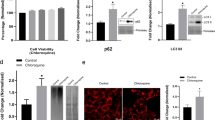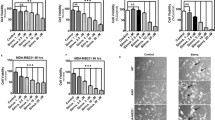Abstract
It has been shown that the treatment with 3β-[2-(diethylamino)ethoxy] androst-5-en-17-one (U18666A) causes the accumulation of cholesterol and the cation-independent mannose 6-phosphate receptor (CIMPR) in late endosomal/lysosomal compartments in BHK cells. The present study reports on a study of the effect of U18666A on CIMPR distribution in more detail in HeLa cells. When cells were treated with U18666A for 20 h, the intense perinuclear signal for CIMPR corresponding to the trans-Golgi network (TGN) disappeared and lamp1-negative punctate signals, scattered in the perinuclear region were detected. CIMPR then began to accumulate in lamp1-positive compartments 48 h after addition of the drug. Double immunofluorescence microscopy showed that U18666A-induced mannose 6-phosphate receptor-containing compartments (U-MPRCs), which were formed in the early phase of the redistribution, contained no marker for the TGN, late endosomes or lysosomes. Approximately half of the structures contained transferrin that had been internalized for 20 min, and cathepsin D, the majority of which appeared to be its precursor form. Immunoelectron-microscopic analysis revealed that U-MPRCs are composed of multivesicular bodies, irregularly shaped structures, and vesicular structures adjacent to the multivesicular bodies. These results suggest that U18666A treatment primarily suppresses the CIMPR transport pathways to late endosomes and from transferrin-containing endosomes, both of which may be dependent on cholesterol function.







Similar content being viewed by others
References
Dell’Angelica EC, Payne GS (2001) Intracellular cycling of lysosomal enzyme receptors: cytoplasmic tails’ tales. Cell 106:395–398
Ezaki J, Wolfe LS, Kominami E (1996) Specific delay in the degradation of mitochondrial ATP synthase subunit c in late infantile neuronal ceroid lipofuscinosis is derived from cellular proteolytic dysfunction rather than structural alteration of subunit c. J Neurochem 67:1677–1687
Ghosh P, Dahms NM, Kornfeld S (2003) Mannose 6-phosphate receptors: new twists in the tale. Nat Rev Mol Cell Biol 4:202–212
Gotow T, Sakata M, Funakoshi T, Uchiyama Y (1996) Preferential localization of annexin V to the axon terminal. Neuroscience 75:507–521
Gruenberg J (2001) The endocytic pathway: a mosaic of domains. Nat Rev Mol Cell Biol 2:721–730
Hall AM, Krishnamoorthy L, Orlow SJ (2003) Accumulation of tyrosinase in the endolysosomal compartment is induced by U18666A. Pigment Cell Res 16:149–158
Hirst J, Futter CE, Hopkins CR (1998) The kinetics of mannose 6-phosphate receptor trafficking in the endocytic pathway in HEp-2 cells: the receptor enters and rapidly leaves multivesicular endosomes without accumulating in a prelysosomal compartment. Mol Biol Cell 9:809–816
Itin C, Rancano C, Nakajima Y, Pfeffer SR (1997) A novel assay reveals a role for soluble N-ethylmaleimide-sensitive fusion attachment protein in mannose 6-phosphate receptor transport from endosomes to the trans Golgi network. J Biol Chem 272:27737–27744
Kobayashi T, Beuchat MH, Lindsay M, Frias S, Palmiter RD, Sakuraba H, Parton RG, Gruenberg J (1999) Late endosomal membranes rich in lysobisphosphatidic acid regulate cholesterol transport. Nat Cell Biol 1:113–118
Lin SX, Mallet WG, Huang AY, Maxfield FR (2004) Endocytosed cation-independent mannose 6-phosphate receptor traffics via the endocytic recycling compartment en route to the trans-Golgi network and a subpopulation of late endosomes. Mol Biol Cell 15:721–733
Lippincott-Schwartz J, Yuan L, Tipper C, Amherdt M, Orci L, Klausner RD (1991) Brefeldin A’s effects on endosomes, lysosomes, and the TGN suggest a general mechanism for regulating organelle structure and membrane traffic. Cell 67:601–616
Liscum L, Faust JR (1989) The intracellular transport of low density lipoprotein-derived cholesterol is inhibited in Chinese hamster ovary cells cultured with 3-beta-[2-(diethylamino)ethoxy]androst-5-en-17-one. J Biol Chem 264:11796–11806
Ludwig T, Griffiths G, Hoflack B (1991) Distribution of newly synthesized lysosomal enzymes in the endocytic pathway of normal rat kidney cells. J Cell Biol 115:1561–1572
Maxfield FR, McGraw TE (2004) Endocytic recycling. Nat Rev Mol Cell Biol 5:121–132
Miwako I, Yamamoto A, Kitamura T, Nagayama K, Ohashi M (2001) Cholesterol requirement for cation-independent mannose 6-phosphate receptor exit from multivesicular late endosomes to the Golgi. J Cell Sci 114:1765–1776
Muno D, Ishidoh K, Ueno T, Kominami E (1993) Processing and transport of the precursor of cathepsin C during its transfer into lysosomes. Arch Biochem Biophys 306:103–110
Press B, Feng Y, Hoflack B, Wandinger-Ness A (1998) Mutant Rab7 causes the accumulation of cathepsin D and cation-independent mannose 6-phosphate receptor in an early endocytic compartment. J Cell Biol 140:1075–1089
Robinson MS, Bonifacino JS (2001) Adaptor-related proteins. Curr Opin Cell Biol 13:444–453
Sexton RC, Panini SR, Azran F, Rudney H (1983) Effects of 3 beta-[2-(diethylamino)ethoxy]androst-5-en-17-one on the synthesis of cholesterol and ubiquinone in rat intestinal epithelial cell cultures. Biochemistry 22:5687–5692
Shinotsuka C, Waguri S, Wakasugi M, Uchiyama Y, Nakayama K (2002) Dominant-negative mutant of BIG2, an ARF-guanine nucleotide exchange factor, specifically affects membrane trafficking from the trans-Golgi network through inhibiting membrane association of AP-1 and GGA coat proteins. Biochem Biophys Res Commun 294:254–260
Umeda A, Fujita H, Kuronita T, Hirosako K, Himeno M, Tanaka Y (2003) Distribution and trafficking of MPR300 is normal in cells with cholesterol accumulated in late endocytic compartments: evidence for early endosome-to-TGN trafficking of MPR300. J Lipid Res 44:1821–1832
Waguri S, Kohmura M, Kanamori S, Watanabe T, Ohsawa Y, Koike M, Tomiyama Y, Wakasugi M, Kominami E, Uchiyama Y (2001) Different distribution patterns of the two mannose 6-phosphate receptors in rat liver. J Histochem Cytochem 49:1397–1405
Waguri S, Dewitte F, Le Borgne R, Rouille Y, Uchiyama Y, Dubremetz JF, Hoflack B (2003) Visualization of TGN to endosome trafficking through fluorescently labeled MPR and AP-1 in living cells. Mol Biol Cell 14:142–155
Acknowledgements
We wish to thank Drs. E. Kominami and T. Kobayashi for kindly providing us with antibodies, and Dr. Hoflack for giving us antibody, and for critical reading of the manuscript. We are also indebted to members of Uchiyama’s lab for helpful discussions.
Author information
Authors and Affiliations
Corresponding author
Additional information
This work was supported by grants from Japan Ministry of Education, Culture, Sports, Science, and Technology.
Rights and permissions
About this article
Cite this article
Tomiyama, Y., Waguri, S., Kanamori, S. et al. Early-phase redistribution of the cation-independent mannose 6-phosphate receptor by U18666A treatment in HeLa cells. Cell Tissue Res 317, 253–264 (2004). https://doi.org/10.1007/s00441-004-0941-3
Received:
Accepted:
Published:
Issue Date:
DOI: https://doi.org/10.1007/s00441-004-0941-3




